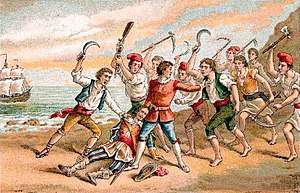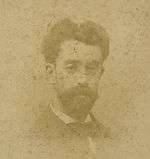Els Segadors
Els Segadors (Eastern Catalan: [əls səɣəˈðos]; "The Reapers") is the official national anthem[1] of Catalonia, nationality[2] and autonomous community of Spain.
| English: The Reapers | |
|---|---|
_01.jpg) | |
National anthem of | |
| Lyrics | Emili Guanyavents, 1899 |
| Music | Francesc Alió, 1892 |
| Adopted | 1993 |
| Audio sample | |
| |
History


The original song dates in the oral tradition to 1640, based on the events of June 1640 known as Corpus de Sang during the Thirty Years' War (1618-1648) between Spain, England, France and Austria, the event that started the Reapers' War or Guerra dels Segadors, also known as the Catalan Revolt,[3] where Catalans fought against the Count-Duke of Olivares, the chief minister of King Philip IV of Spain. The song describes the event, an uprising of peasants due to the large presence of the Royal army in the Principality of Catalonia, as there were required to lodge and provision the troops, creating a large tension and discomfort and leading to episodes such as religious sacrileges, destruction of personal properties and rape of women by the soldiers. The second part of the song tells the arrival of the rebel reapers in Barcelona, who kill various guards, the royal officers and the viceroy of Catalonia, Dalmau de Queralt, ending with the exhortation to Catalans to take the arms, as they are at war.
In the 19th century, the text was compiled in the Romancillero Catalán, a book of folk traditions written by Manuel Milà i Fontanals. The music was standardized by Francesc Alió in 1892.[3] Its modern lyrics were written by Emili Guanyavents, who won a competition convened by the political party Unió Catalanista in 1899, simplifying the text to three verses. At the time, the change of lyrics caused some controversy among conservative elements, as Guanyavents, coming from sectors close to anarchism, gave them a revolutionary tone.
Since the beginning of the 20th century, Els Segadors became one of the most relevant symbols of catalanism and Catalonia itself, increasing its popularity during the Second Spanish Republic and the Civil War. Despite an attempt of the Generalitat de Catalunya (Catalan autonomous government) in 1931 to replace it with another song, El Cant del Poble, Els Segadors remained highly popular, treated by Catalan government and population as the national anthem. The dictatorship of Francisco Franco (1939-1975) banned the public use of Catalan national symbolism, among them Els Segadors. Tolerated songs, such as the Virolai or La Santa Espina, were often played in its place to express Catalan identity.
After decades used de facto, sometimes alongside the Cant de la Senyera, the Catalan government officialy adopted Els Segadors as the national anthem of Catalonia in 25 February 1993, by law of its parliament. The official version was made in 1994. The new Statute of Autonomy of Catalonia of 2006 confirms this decision by its article 8.4.[4]
Lyrics
|
|
Recordings and variations
Contemporary Catalan composer Jordi Savall made a version of the folk song, using the original narrative (which dates back to the seventeenth century) combined with the modern lyrics and refrain, which were added later. The song has also been recorded and interpreted by major artists, included on albums such as Traditional Catalan Songs (Victoria de los Ángeles).
In October 2017, American band A Sound of Thunder released a heavy metal variation of the anthem, using a mix of English and Catalan lyrics.[8]
See also
References
- "Law 1/1993, 25 February, of the national anthem". dogc.vlex.es. Retrieved 14 September 2019.
- "First article of the Statute of Autonomy of Catalonia. 'Catalonia, as a nationality, exercises its self-government constituted as an autonomous community...'". gencat.cat. Retrieved 30 June 2018.
- Generalitat de Catalunya: National symbols Archived October 16, 2013, at the Wayback Machine
- "Statute of Autonomy of Catalonia, Article 8.1: "The flag, the holiday and the anthem are the national symbols of Catalonia, defined as a nationality by Article 1"" (PDF). parlament.cat. Retrieved 14 September 2019.
- "These people" the oppressors of the Catalan people, who back in that time invaded Catalonia
- the Segadors Revolt which the song references took place in June.
- The verb in the Catalan original—seguem—is from the same root as segadors; that is, they will cut the chains as they cut the crops.
- https://www.asoundofthunderband.com/single-post/2017/10/05/Hola-Catalunya
External links
| Wikisource has original text related to this article: |